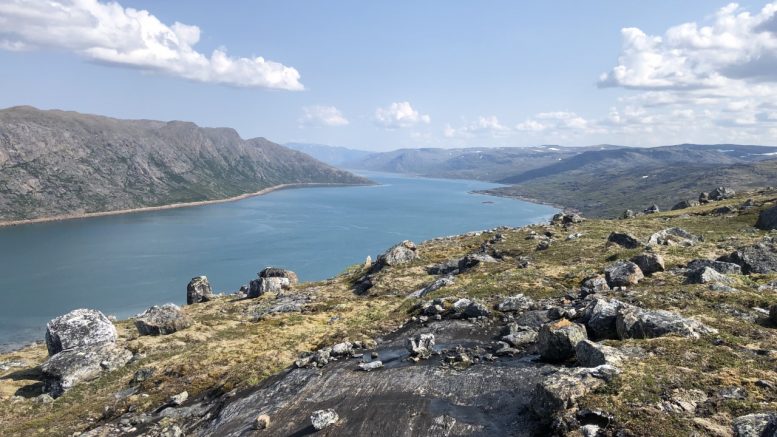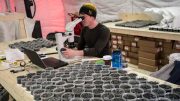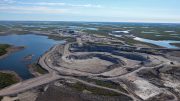With a new strategy focused on diamonds that officially launched in March, just as the coronavirus pandemic began to spread across the globe, you might think that EHR Resources (ASX: EHX) had some regrets about its timing.
But you would be wrong.
EHR managing director Peter Ravenscroft says the idea behind the company’s new strategy – to create a “diamond project incubator” with a portfolio of select projects – is built on taking advantage when diamonds are out of favour.
“The whole thesis we’re working on is being countercyclical,” Ravenscroft said in an interview in June. “In other words, when things are at the bottom of the cycle is a good time to buy assets and invest in projects. So our immediate reaction when the pandemic struck and the economic impact of that, if you believe in being countercyclical, then things just got better.”
With two earn-in deals announced in the first two weeks of June, including one with North Arrow Minerals (TSXV: NAR) on its Naujaat project in Nunavut, EHR is certainly finding diamond projects in need of funding.
In building its portfolio, EHR is looking for projects that have been advanced in the past, but a lack of funding has left questions around their potential value.
“Underlying all the acquisitions is the philosophy that there are a number of unanswered questions in the diamond space,” Ravenscroft says. “Let’s go back and look at things that people have walked away from for whatever reason and make sure there wasn’t an opportunity left behind.”
While Ravenscroft has been trying to put together a diamond project incubator for several years now, he wasn’t able to make progress with the idea until last year, when he approached Australian mining entrepreneur Michael O’Keefe.
Now based in Canada and chairman of Champion Iron Mines (TSX: CIA; AS: CIA), O’Keefe also had an interest in diamonds, and controlled private company Nanuk Diamonds.
“He is a contrarian investor, he likes to look at countercyclical trends, which is what he’s done in iron ore,” Ravenscroft says.
The two men decided to pool resources using EHR, an Australian listed shell company controlled by O’Keefe, and in a related-party transaction that won shareholder approval in March, EHR acquired Nanuk Diamonds and its Nanuk project in northern Quebec for A$1 million in shares. That’s when Ravenscroft took over as managing director of EHR.
Option agreements
Under the North Arrow deal announced June 1, EHR can earn a 40% interest in Naujaat by investing $5.6 million to collect a 1,500-2,000 tonne bulk sample at the Q1-4 kimberlite next year. EHR has already provided $300,000 for North Arrow to secure supplies for this year. In order to earn an initial stake in the project, EHR must raise the remainder of the funds before next April.
The two parties have also signed a non-binding agreement to negotiate a second option agreement whereby EHR can earn another 20% stake by funding a 10,000-tonne bulk sample.
The key question at Naujaat revolves around the rare, orangey-yellow coloured diamonds that have been recovered from Q1-4, says Ravenscroft.
“The population of orangey-yellow diamonds is unique to that project and a very exciting part of the project,” he says. “The question that needs to be answered is whether there are enough of those diamonds in that specific colour and do they extend into the larger diamond sizes? If so, the (diamond) price could be significantly higher than currently thought and would make the economics attractive.”
The Q1-4 kimberlite hosts an inferred resource of 48.8 million tonnes grading 53.6 carats per hundred tonnes for 26.1 million carats.
On June 9, EHR announced a deal with Diamond Exploration Strategies (DES), a private company with five projects in Botswana.
The DES team are all former De Beers employees, and have amassed more than 2,000 sq. km of prospective ground containing many high-priority targets, including kimberlites found by De Beers.
EHR will provide US$1.5 million over three years, including US$300,000 in the first 12 months, to earn a 50% stake in any discoveries made. It has an option to earn up to 70% of a designated project by funding a scoping study, and up to 90% by funding a feasibility study.
For both the North Arrow and DES acquisitions, the current teams will remain the operators, with decisions on programs and budgets made by a joint technical committee.
“It’s kind of a win-win because we’re bringing the funding, which is very difficult for them to raise and we’re bringing a deep knowledge of the industry and the technical aspects,” Ravenscroft says. “Add that to their operational ability and local knowledge, and we think that’s a very strong combination.”
Ravenscroft, who is trained as a geostatician and is a specialist in diamond resource estimation, brings 40 years of experience in diamonds, including with De Beers, Rio Tinto and Dominion Diamonds. (At Rio Tinto, he was the qualified person for diamonds across the group, worked on the prefeasibility for the Diavik mine, and ran the resource definition stage of drilling.) EHR will soon also be bringing in others with diamond expertise.
Rounding out EHR’s portfolio is its 100%-owned Nanuk project, acquired in March. Located in the Ungava Bay region of Quebec, the 274-sq.-km project contains several diamond-bearing kimberlitic dykes that were found in the early 2000s but left unexplored for the last 15 years.
“It’s a dyke-based project, so by definition, dykes are smaller and pretty high cost to mine,” Ravenscroft says. “The conclusion at the time was that the economics wouldn’t work.”
However, remote sensing work done by Nanuk Diamonds in 2018 identified some potential blows or larger occurrences, as well as anomalies that could be kimberlites, making the project worth another look. The company is currently awaiting microdiamond results from a surface sampling program conducted last winter.
Next steps
The company is looking to add another two to three projects to its portfolio over the next year in Canada, Botswana or Australia – in that order of priority.
“We love Canada in terms of the stability and the lack of sovereign risk,” Ravenscroft says. “The geology is fantastic for diamond exploration, there’ve been a number of successes over the years, and we believe there are still discoveries to be made and projects to be developed.”
Despite the interest in Canada, the company has no current plans for a Canadian listing.
EHR has around $1 million in working capital, but will be looking to raise a minimum of $5.5 million (to fund the North Arrow transaction) in the next couple of months, mostly from Australian investors.
The current low prices and lack of demand for diamonds may scare off the majority of investors, but there is interest from investors with a longer term view.
“The kind of investors we’re talking to down in Australia are investors with a three- to five-year view,” Ravenscroft says.
Those investors share EHR’s belief that the diamond sector has been underfunded for too long.
“The key aspect of why we’re so interested in diamonds in the first place is that there is a general consensus on a shortfall in supply over the next 5-10 years and inadequate spend in terms of exploration and project development,” he says. “Knowing that makes investing at this part of cycle make a lot of sense.”





Be the first to comment on "EHR Resources launches diamond ‘incubator’"